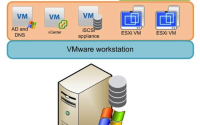03 Feb 2015
Key features and configuration maximum differences between vSphere 5.5 & vSphere 6
VMware vSphere® 6.0 introduces many enhancements to VMware vSphere Hypervisor, VMware virtual machines, VMware vCenter Server™, virtual storage, and virtual networking.
Some of the key configuration maximum differences between vSphere 5.5 and vSphere 6 are as below -
| Features | vSphere 5.5 | vSphere 6 |
| Physical RAM per host | 4 TB | 12 TB |
| Physical CPUs per host | 320 | 480 |
| Virtual Machines Per host | 512 | 2048 |
| Maximum vCPUs per Virtual Machine | 64 | 128 |
| VM Hardware Version | 10 | 11 |
| Max. Virtual Machine RAM | 1TB | 4TB |
| Hosts Per Cluster | 32 | 64 |
| Virtual Machines Per Cluster | 4000 | 8000 |
| vCPUs for FT enabled VM | 1 | 4 |
| Virtual Disk Type for FT VMs | Thick Provision-Eager Zeroed | Thick, Thin Provision |
| vCenter Server Appliance With Embedded Database support upto |
100 Hosts and 3000 Virtual Machines |
1000 hosts and 10000 virtual machines |
Some of the features which are supporting/available from vSphere 6
| Features | vSphere 5.5 | vSphere 6 |
| vCenter with Embedded Platform Service Controllers | No | Yes |
| Snapshots for FT enabled VM’s | No | Yes |
| vMotion between datacenter/vCenters | No | Yes |
| Virtual Volumes | No | Yes |
| Linked Mode between Windows based vCenter and vCenter Appliance | No | Yes |
VMware vSphere® 6.0 empowers users to virtualize any application with confidence, redefines availability, and simplifies the virtual data center. The result is a highly available, resilient, on-demand infrastructure that is the ideal foundation for any cloud environment. This release contains the following new features and enhancements
Compute
- Increased Scalability – Increased configuration maximums: Virtual machines will support up to 128 virtual CPUs (vCPUs) and 4TB virtual RAM (vRAM). Hosts will support up to 480 CPU and 12TB of RAM, 2,048 virtual machines per host, and 64 nodes per cluster.
- Expanded Support – Expanded support for the latest x86 chip sets, devices, drivers, and guest operating systems.
- Amazing Graphics – NVIDIA GRID™ vGPU™ delivers the full benefits of NVIDIA hardware-accelerated graphics to virtualized solutions.
- Instant Clone* – Technology, built in vSphere 6.0, that lays that foundation to rapidly clone and deploy virtual machines, as much as 10x faster than what is currently possible today.
Storage
- Transform Storage for your Virtual Machines – vSphere Virtual Volumes* enables your external storage arrays to become VM-aware. Storage Policy-Based Management (SPBM) allows common management across storage tiers and dynamic storage class of service automation. Together they enable exact combinations of data services (such as clones and snapshots) to be instantiated more efficiently on a per VM basis.
Network
- Network IO Control – New support for per-VM Distributed vSwitch bandwidth reservations to guarantee isolation and enforce limits on bandwidth.
- Multicast Snooping – Supports IGMP snooping for IPv4 packet and MLD snooping for IPv6 packets in VDS. Improves performance and scale with multicast traffic.
- Multiple TCP/IP stack for vMotion – Allows vMotion traffic a dedicated networking stack. Simplifies IP address management with a dedicated default gateway for vMotion traffic.
Availability
- vMotion Enhancements – Perform non-disruptive live migration of workloads across distributed switches and vCenter Servers and over distances of up to 100ms RTT. The astonishing 10x increase in RTT offered in long-distance vMotion now makes it possible for data centers physically located in New York and London to migrate live workloads between one another.
- Replication-Assisted vMotion* – Enables customers, with active-active replication set up between two sites, to perform a more efficient vMotion resulting in huge time and resource savings – as much as 95 percent more efficient depending on the size of the data.
- Fault Tolerance (up to 4-vCPUs) – Expanded support for softwarebased fault tolerance for workloads with up to 4 virtual CPUs.
Management
- Content Library – Centralized repository that provides simple and effective management for content including virtual machine templates, ISO images and scripts. With vSphere Content Library, it is now possible to store and manage content from a central location and share through a publish/subscribe model.
- Cross-vCenter Clone and Migration* – Copy and move virtual machines between hosts on different vCenter Servers in a single action.
- Enhanced User Interface – Web Client is more responsive, more intuitive, and more streamlined than ever before.

